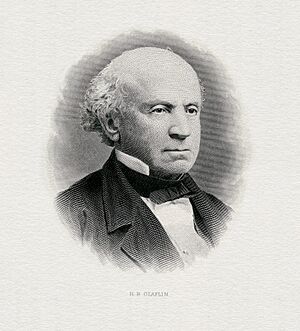- This page was last modified on 17 October 2025, at 10:18. Suggest an edit.
H.B. Claflin & Company facts for kids
H.B. Claflin & Company was a big business in Manhattan, New York. It started in 1843 and became an official company in 1890. They were a wholesaler of "dry goods." This means they bought things like fabrics, clothing, and blankets from manufacturers. Then, they sold these items in large amounts to smaller stores. They were like a middleman between the factories and the shops you might visit. Sadly, the company faced big money troubles in June 1914. They owed a lot of money, and a judge had to appoint people to help manage the company. The business struggled because the dry goods industry moved to a new part of Manhattan. Also, the company didn't change its ways to keep up with new business trends.
History
How It Started
H.B. Claflin & Company began its journey in 1843. This was many years before it officially became a corporation. By 1868, the company still had its original leaders. These included Horace Brigham Claflin, E.E. Eames, and E.W. Bancroft.
The main building of the business was very large. It stretched for 100 feet along Church Street (Manhattan). It also went for 400 feet along Worth Street. The building continued for another 100 feet along West Broadway (Manhattan). All its buildings covered a huge area of about 48,000 square feet in 1868.
The company employed many people. About 700 full-time workers were on staff. During busy times, this number could go up to 1,000 people. H.B. Claflin & Company had many different departments. They sold a wide range of items. These included lace goods, white fabrics, flannels, and blankets. They also sold hosiery, shirts, underwear, shawls, hoods, scarves, and gloves.
Later Years and Decline
By 1914, H.B. Claflin & Company controlled several stores in New York. These included well-known names like Lord & Taylor and James McCreery & Company. They also owned C.G. Gunther's Sons, O'Neill Adams Company, and H. Batterman Company. In Brooklyn, they controlled the Bedford Company.
Beyond New York, Claflin interests owned about thirty more stores. These stores were located in various parts of the United States. However, despite their size, the company ran into serious money problems in June 1914. They owed a large amount of money, about $34,000,000.
A judge named Learned Hand from the United States District Court in New York stepped in. On June 25, 1914, he appointed people to take over the company. These people, called receivers, tried to sort out the company's finances. The business struggled because the dry goods industry started moving to a different part of uptown Manhattan. Also, the company didn't change its ways to keep up with new business trends. This failure to adapt led to its downfall.

